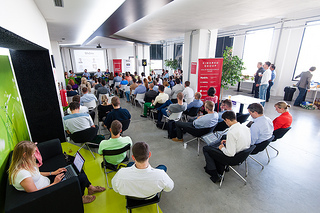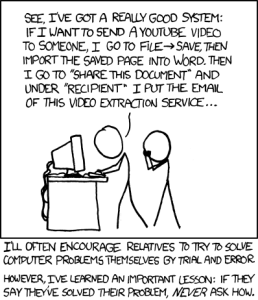16 Interviews With Founders. What Did We All Learn?
Last Friday, investors and mentors from Startupyard met with 16 candidates, chosen from the most promising of a total of 60 applicant teams for the upcoming accelerator round.
I was there, not to participate in the interviews or to vote on who would be included, but to see what sorts of teams I might be working with come April. The results were intriguing, and the following are a few of my takeaways from the process.
Many Teams Didn’t Have a “Pitch”
This is understandable, considering that in a few cases, the teams also didn’t have a real product or a market fit. That’s what we’re here for. Not having a finished pitch at certain stages of the process is fine, but it seemed that a few of the teams ought to have thought longer and paid a little more attention to selling their ideas. When there is, as we say “money in the room,” meaning that people are making real financial decisions about you and your team, and not only your ideas, teams should be prepared to sell whatever they have, even if it is just their own promising talents. In fact, there was interest in some teams based purely on their personal talents, and much less on their specific ideas.
Having a pitch of some kind also signals to the investors in the room that you have at least thought about the marketability of your ideas. A few of the teams had clearly rehearsed precise lines and questions they would use to pitch their ideas, and while our interviewers saw through these ploys, having a bit of a sales spiel is not insulting to an investor. To the contrary, comments on interviewees who attempted honest sales pitches were very positive: “at least he’s clearly thought about the market,” was one comment following such an interview.
Start Thinking About Your Market
This was a big one at the table on Friday. Some teams struggled to define who their customers might be. If you can’t imagine who might pay for your services, then it may be difficult to get an investor to agree to anything at all. An interview for an accelerator is not an investor meeting, but the accelerator is still investing some money, and good deal of time and energy, into your ideas. So having some ideas, at least, of potential markets for your products can help to convince the accelerator that you’ll be able to find a market- that you think in those terms when you need to.
You don’t have to have any customers to know something about who might buy your products (most of our applicants don’t have any current customers), but you do need to have any idea of where the value of your product is. In other cases, the products being described filled very crowded markets. If your product is already essentially a feature of a more successful product, that may be fine. However, you have to be able to reasonably justify why your product adds value that the competitor doesn’t. And you have to be prepared for the investors to ask questions about your more visible competition: why would someone end up using your product or service, if it is included in a competing platform? Is it cheaper, more streamlined, more appealing in some other way?
What Problem are You Solving?
There were two initial questions that Cedric Maloux, our CEO, asked every team, and the answers were probably the most telling about how far along each team was in thinking about their product or services as a real, viable business. “What problem does your product or service solve,” and “what are the extant alternatives?” The ideal answer was clearly that the product solves a serious, possibly costly problem, and that there are no current alternatives. More often the case was that the problem was one of convenience, of cost, or of lost efficiencies, and the alternative was either business as usual, or an alternative product with a different focus.
The most pressing problem that some teams had in answering this question was that they attempted to pose the problem as being related to their exact product, rather than a broader problem.
For example, we heard from founders who said something like this:
Founder : “I make a watch that runs backwards.” Cedric: “And what problem does that solve.” Founder: “Well, it solves the problem of someone who is looking for a watch that runs backwards.” Cedric: “And what are the current alternatives?” Founder: “Watches that run forwards are pretty much the only option.” Cedric: “… I’m not sure what the problem is that you are solving.” Founder: “If you needed a watch that ran backwards, I would be able to give you that.”In some cases, the interviewers found themselves answering this question for the founder, when it should have been the other way around, finding uses for the backwards running watch that the founder had not proposed. These resulted in negative marks against those applicants- a founder that doesn’t think in terms of the market and in terms of solving problems may not be a desirable candidate for an accelerator.
It clearly wasn’t, for the interviewers, that the founder needed to know all use-cases of their product ideas, but they had to have some use cases for them. And “if you wanted to [do exactly what my product does]” is not a use-case. Products have to be adaptable to different purposes: they have to appeal to customers who themselves need different things.
The Team on Paper and the Team in Person are Two Vastly Different Things
There were a couple of teams that barely made it into the interviews, because on paper, their projects didn’t seem like ideas with a lot of potential. But when they got in front of us, they blew us all away with their energy, and their insights into how they would make their business ideas work. And the opposite was also true: we entered one interview virtually certain that the team would impress us, because the idea sounded great on paper. But the interview proved that while the idea seemed good on paper, the founder in question didn’t have the energy or the interest he needed to convince us to accept him. Cedric, who led the interviews, commented afterwards that it was a powerful example of how much depends upon founders themselves, and not just their ideas.
Gadget Startups Are Very Risky
A gadget based startup, or one that needs a physical product in order to realize their sales, are risky. We had a few pitches for physical products, and they were actually very good pitches, and excellent ideas. The problem is that the burden of proof that such a product will work and will be attractive to a market is much higher than for a purely software product. Not only do the founders need to know much more about their market, including the costs and challenges of manufacturing the product, but they also risk a much larger upfront investment in a technology that may not sell later on. This is in fact why gadget startups with physical products so often turn to preselling and crowdfunding, as has been the case for startups like Pebble, Tile, and Omni. Physical products are very attractive for preselling because the customers can be identified and locked-in long before the investment is actually made, guaranteeing at least a shot at profitability. Building and marketing a device from scratch, without an existing customer base, is therefore doubly unattractive for an accelerator.
Does your Product Have Global Potential? Does it scale?
Teams were sometimes not aware of what their competition was, especially when asked about the market outside of their home country. Accelerators in general, especially ones like Startupyard, focused on data and analytics, are looking for startups with global potential, so ideas that work in smaller markets that require a great deal of TLC (that’s Tender Loving Care), are not going to fare well in this kind of environment. The elements of a product that can make it a success in a local market can work against it in a larger one, presenting problems like language dependence, organic growth limits, and scalability of service and of sales. This doesn’t mean these products are bad, just that they may not be right for an accelerator. If a product would benefit more from slow local adoption with personalized sales and marketing, then it shouldn’t be in an accelerator at all, and some ideas are best grown city-to-city, gaining their greatest value from their local nature, rather than wider adoption and more aggressive growth.
Do Rapid Prototyping
We’ve written about this before, and it remains important. Teams often didn’t have a product to show us because they were working on the demanding problems that their backends presented. While that’s the right idea, some modest attempt at demonstrating the end-user functionalities involved would have gone miles towards convincing the board of Startupyard to take a second look at a few projects. Even non-functional mockups of the end product can make a product much more tangible and attractive than a description can. A picture is worth a thousand words, not because pictures are better, but because they inspire the imagination. They feel real, even when talking about an abstract idea just doesn’t.
Rapid prototyping can also help founders to define what exactly it is that their products do. A prototype virtually demands that a the designer at least start imagining use cases for the product. This is why rapid-prototyping can be so important: it is more than a demonstration- it is a piece of the process of envisioning your finished product, and the customer who will use it.
Give Specific Answers to Specific Questions
Nerves play a big part in these types of interviews, and the interviewers understand that. But at the same time, not every question is a test, and not every answer needs to be perfect. If an interviewer asks you a simple yes or no question “do you have any paying customer?” for example, you should start by answering yes or no. While for some people, the instinct is to get out ahead of the question, and to answer the concerns they think it raises, often times the interviewer is really interested in something else, and a straightforward answer, followed by a short explanation, is always the best way to go.
Be honest, and trust that the interviewer will seek the information he or she needs to make the appropriate judgements. If you answer a question like that one with “well, right now, we’re not worried about the monetization because we’re still growing the userbase, and we think that…,” the interviewer will not know the answer to the question, and will be frustrated at having to ask it again. And it’s likely the interviewer just wants to know the status of your product or service, not in using that information to judge your competence. The right answer might be “Yes, we have a few paying customers, but growth is slow because…” or “No, however we are still concentrating on growing our user base.”
One of the most pleasing moments during the interviews came when a very young founder answered a question about his company’s scalability by saying: “I’m just not sure about that.” There was a visible reaction from the table of interviewers, and you could see them thinking: “here is someone being honest about himself!” You run the risk of outsmarting yourself, by trying to figure out what answers the interviewers want to hear: just answer the questions as they are asked.
Appearances Matter
Much study has been done of the links between attractiveness and trust. We don’t consider ourselves shallow judges of character, and the point of being a professional investor and a mentor for startups is having the ability to look beyond appearances and see potential where other people don’t. But all the same, the way you look sends important signals about how you work with other people, what you think about yourself, and how aware you are of these things.
While nobody arrived for their skype interviews in their pajamas, my personal observation was that the more professional looking teams were taken more seriously. While this is as much a function, I think, of how those teams behaved and spoke, and were aware of the questions that needed to be answered, and how they needed to be approached, the psychology of appearance can be just as important for the interviewee as for the interviewer. Taking 10 minutes to think about what shirt you’re wearing, the expression on your face, and even the placement of your webcam and lighting fixtures (for an online interview), can give you confidence and perceived control over the interview, that will translate to answers coming more easily, and with fewer hiccups. An interviewer will remember how you looked when they spoke to you, and you want to look like someone that they could work with for 3 months.
[ssba]









